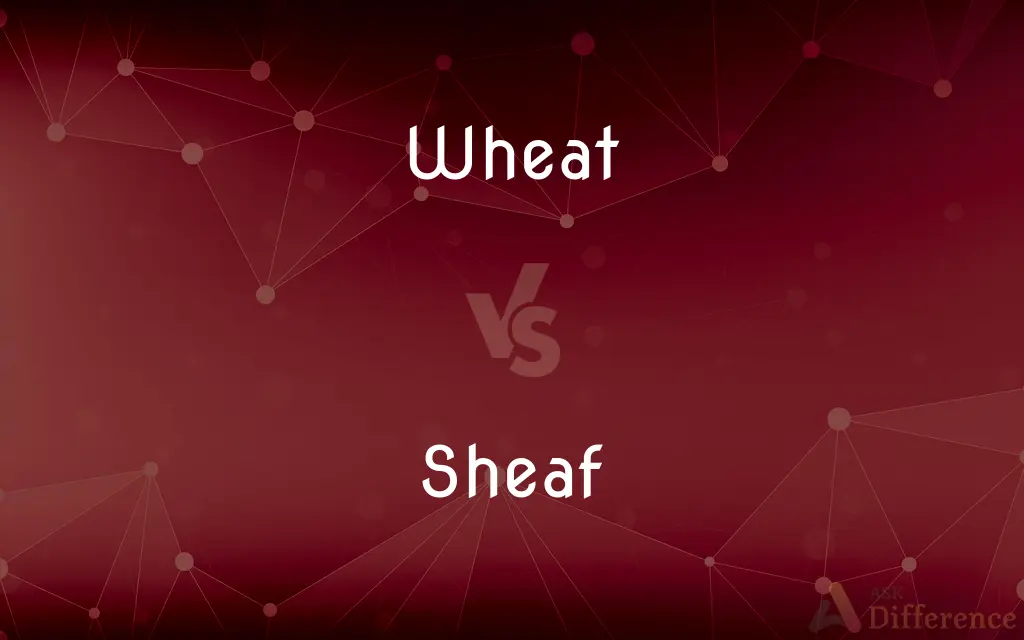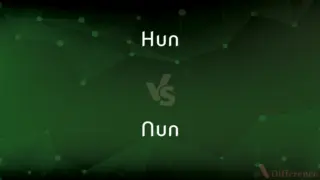Wheat vs. Sheaf — What's the Difference?
By Tayyaba Rehman & Fiza Rafique — Updated on April 2, 2024
Wheat is a type of cereal grain, while a sheaf is a bundle of harvested stalks, typically of wheat or other grains.

Difference Between Wheat and Sheaf
Table of Contents
ADVERTISEMENT
Key Differences
Wheat is a cereal grain that's a staple food in many parts of the world, known for its adaptability to different climates and soils. It's processed into flour for bread, pasta, and other foods. On the other hand, a sheaf refers to a bundle of harvested grain stalks, often bound together after reaping. This term is not specific to wheat and can refer to other grains, but wheat is commonly associated with sheaves due to its significance in agriculture.
While wheat is grown and harvested for its seeds, which are ground into flour, the concept of a sheaf is more about the method of gathering and temporarily storing stalks during harvest. Sheaves are traditionally made by hand, although modern farming uses machinery for most of the process, including the bundling of grain stalks into larger, machine-compatible units.
The significance of wheat lies primarily in its role as a food source, being a major ingredient in diets worldwide due to its nutritional content and versatility. A sheaf, however, holds more of a symbolic significance in many cultures, representing harvest, abundance, and the agricultural cycle. It's often used in decorations, ceremonies, and as a motif in art and literature.
Cultivation of wheat involves specific agricultural techniques, including crop rotation, pest control, and harvesting methods tailored to the type of wheat being grown and the climate of the area. The creation of a sheaf is part of the post-harvest process and has evolved with farming technology, from hand-tying stalks to mechanical bundling, reflecting changes in agricultural practices over time.
The distinction between wheat and a sheaf is clear: wheat refers to the plant and its grains, essential for food production, while a sheaf is a practical and symbolic way of handling harvested stalks. This difference underscores the relationship between the agricultural process of growing crops and the cultural practices that have developed around harvest time.
ADVERTISEMENT
Comparison Chart
Definition
A cereal grain used for food.
A bundle of harvested stalks of grain.
Primary Use
Food production (flour, bread, pasta).
Harvesting and symbolic purposes.
Significance
Nutritional and culinary value.
Cultural and agricultural symbolism.
Production Process
Cultivation, harvesting, and milling into flour.
Gathering and binding harvested stalks.
Varieties
Numerous (e.g., hard red, soft white).
Not applicable, but can include various grain types.
Compare with Definitions
Wheat
Wheat is rich in carbs, protein, and vitamins.
Whole wheat flour is a healthy dietary option.
Sheaf
Making sheaves is part of the harvesting process.
Now often mechanized in modern farming.
Wheat
Wheat is a staple food grain.
Used to make bread, pasta, and cereal.
Sheaf
Appears in art, literature, and religious texts.
Sheaves are mentioned in the Bible as symbols of abundance.
Wheat
It's grown worldwide, adapting to various climates.
Wheat fields span from the US to China.
Sheaf
While commonly associated with wheat, it can include other grains.
Barley sheaves are also common in certain regions.
Wheat
There are many types, like hard red winter wheat.
Used for making bread due to its high gluten content.
Sheaf
A sheaf is a bundle of grain stalks bound together after harvesting.
Traditionally made by hand in fields.
Wheat
Requires specific conditions, including climate and soil.
Wheat cultivation is prominent in temperate regions.
Sheaf
Often symbolizes harvest and fertility.
Sheaves are used in harvest festivals and decorations.
Wheat
Wheat is a grass widely cultivated for its seed, a cereal grain which is a worldwide staple food. The many species of wheat together make up the genus Triticum; the most widely grown is common wheat (T. aestivum).
Sheaf
A bundle of cut stalks of grain or similar plants bound with straw or twine.
Wheat
A cereal which is the most important kind grown in temperate countries, the grain of which is ground to make flour for bread, pasta, pastry, etc.
Sheaf
A collection of items held or bound together
A sheaf of printouts.
Wheat
Any of various annual cereal grasses of the genus Triticum of the Mediterranean region and southwest Asia, especially T. aestivum, widely cultivated in temperate regions in many varieties for its commercially important edible grain.
Sheaf
An archer's quiver.
Wheat
The grain of any of these grasses, ground to produce flour used in breads, pasta, and other foods.
Sheaf
To gather and bind into a bundle.
Wheat
(countable) Any of several cereal grains, of the genus Triticum, that yields flour as used in bakery.
Sheaf
A quantity of the stalks and ears of wheat, rye, or other grain, bound together; a bundle of grain or straw.
Wheat
(uncountable) A light brown colour, like that of wheat.
Sheaf
Any collection of things bound together.
A sheaf of paper
Wheat
Wheaten, of a light brown colour, like that of wheat.
Sheaf
A bundle of arrows sufficient to fill a quiver, or the allowance of each archer.
Wheat
A cereal grass (Triticum vulgare) and its grain, which furnishes a white flour for bread, and, next to rice, is the grain most largely used by the human race.
Sheaf
A quantity of arrows, usually twenty-four.
Wheat
Annual or biennial grass having erect flower spikes and light brown grains
Sheaf
(mechanical) A sheave.
Wheat
Grains of common wheat; sometimes cooked whole or cracked as cereal; usually ground into flour
Sheaf
(mathematics) An abstract construct in topology that associates data to the open sets of a topological space, together with well-defined restrictions from larger to smaller open sets, subject to the condition that compatible data on overlapping open sets corresponds, via the restrictions, to a unique datum on the union of the open sets.
Sheaf
(transitive) To gather and bind into a sheaf; to make into sheaves
To sheaf wheat
Sheaf
(intransitive) To collect and bind cut grain, or the like; to make sheaves.
Sheaf
A sheave.
Sheaf
A quantity of the stalks and ears of wheat, rye, or other grain, bound together; a bundle of grain or straw.
The reaper fills his greedy hands,And binds the golden sheaves in brittle bands.
Sheaf
Any collection of things bound together; a bundle; specifically, a bundle of arrows sufficient to fill a quiver, or the allowance of each archer, - usually twenty-four.
The sheaf of arrows shook and rattled in the case.
Sheaf
To gather and bind into a sheaf; to make into sheaves; as, to sheaf wheat.
Sheaf
To collect and bind cut grain, or the like; to make sheaves.
They that reap must sheaf and bind.
Sheaf
A package of several things tied together for carrying or storing
Common Curiosities
Why are sheaves used in harvest festivals?
Sheaves symbolize the bounty of the harvest and are used in festivals to celebrate agricultural abundance.
What does a sheaf represent?
A sheaf often represents harvest, abundance, and fertility, symbolizing the completion of the agricultural cycle.
Can sheaves be made from other grains besides wheat?
Yes, sheaves can be made from other grains like barley and oats, not just wheat.
What are the main types of wheat?
The main types include hard red, soft white, and durum, each suited for different food products.
What is wheat used for?
Wheat is primarily used for food, including bread, pasta, and cereal, due to its nutritional content.
What role does wheat play in nutrition?
Wheat provides carbohydrates, protein, and fiber, making it an important part of a balanced diet.
How is wheat harvested?
Wheat is harvested using combines that cut, thresh, and clean the grains in one operation.
How do modern practices affect the making of sheaves?
Modern farming uses machinery, reducing the need for hand-tied sheaves, though they remain a cultural symbol.
Why is wheat important to the global economy?
Wheat is a staple food for a large portion of the world's population, making it a crucial agricultural commodity.
Can sheaves still be found in modern agriculture?
While less common due to mechanization, sheaves may still be made for decorative or symbolic purposes.
Is wheat cultivation environmentally sustainable?
Wheat cultivation varies in sustainability; practices like crop rotation and reduced chemical use improve its environmental impact.
What's the difference between whole wheat and refined wheat?
Whole wheat contains all parts of the grain, offering more nutrients, while refined wheat is stripped of the bran and germ.
Are sheaves relevant in today's farming?
Mechanization has reduced their practical relevance, but sheaves remain significant in cultural and symbolic contexts.
What challenges does wheat farming face?
Challenges include climate change, pests, and diseases, which can affect yield and quality.
How are sheaves made?
Traditionally, sheaves are made by hand-tying stalks of harvested grain, though machinery has largely taken over this process.
Share Your Discovery

Previous Comparison
Appointment vs. Contract
Next Comparison
Hun vs. NunAuthor Spotlight
Written by
Tayyaba RehmanTayyaba Rehman is a distinguished writer, currently serving as a primary contributor to askdifference.com. As a researcher in semantics and etymology, Tayyaba's passion for the complexity of languages and their distinctions has found a perfect home on the platform. Tayyaba delves into the intricacies of language, distinguishing between commonly confused words and phrases, thereby providing clarity for readers worldwide.
Co-written by
Fiza RafiqueFiza Rafique is a skilled content writer at AskDifference.com, where she meticulously refines and enhances written pieces. Drawing from her vast editorial expertise, Fiza ensures clarity, accuracy, and precision in every article. Passionate about language, she continually seeks to elevate the quality of content for readers worldwide.
















































